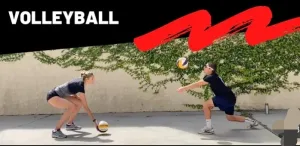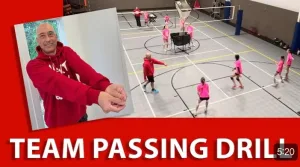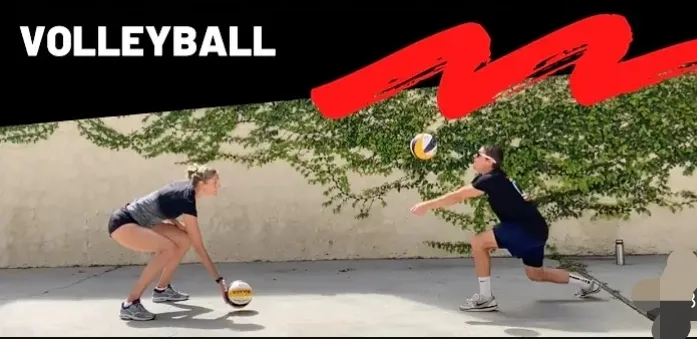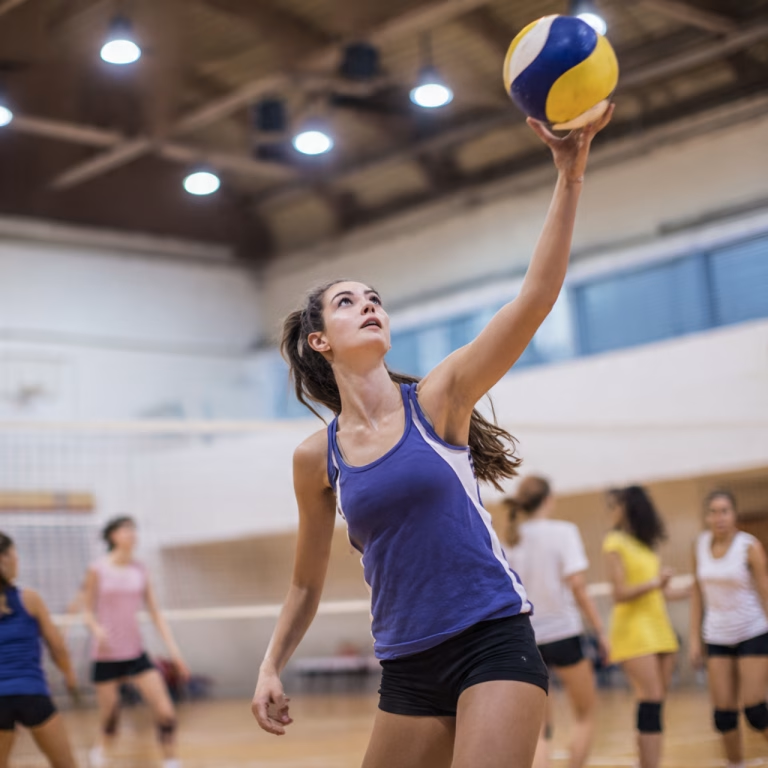Passing is one of the most important skills in volleyball. Whether you’re playing on the beach or an indoor court, having strong passing skills is essential for success. In this article, we’ll walk you through some effective volleyball passing drills that will improve your game and help you become a reliable player on the court. From beginner-level drills to advanced team exercises, these drills will build your confidence and consistency.
Let’s dive right in and explore how you can elevate your passing game!
Why is passing so important in volleyball?
Passing is the first step to building a successful attack. If a pass isn’t accurate, it becomes harder for the setter to make a good set, which means the hitter may struggle to make a strong attack. Imagine the pressure during a tight match—every pass counts! A great passer stays calm, reads the ball well, and makes smart decisions.
Mastering the right passing technique gives your team the advantage. And the only way to get better? Consistent practice with volleyball passing drills.
Volleyball Passing Drills for Every Skill Level

1. Basic Passing Drills for Beginners
-
Wall Passing Drill
How it works: Stand about 5 feet from a wall and pass the ball against it continuously.
Why it helps: This drill improves ball control and teaches players to keep their passes straight.
Pro tip: Focus on hitting the same spot on the wall each time to build consistency.
See Also: 19 Best Volleyball Drills for Beginners
-
Partner Passing Drill
How it works: Find a partner and pass the ball back and forth while standing 10 feet apart.
Why it helps: This drill teaches players how to react to different passes and builds teamwork.
Example: Coaches often start warm-ups with this drill to build rhythm before practice.
-
Shuffle Passing Drill
How it works: Move sideways (shuffle) while passing the ball with a partner.
Why it helps: This drill helps players practice passing while on the move, which is important for in-game situations.
See Also: Volleyball Hitting Drills: Improve Your Spike, Power, and Accuracy
2. Intermediate Passing Drills to Improve Control
-
Target Passing Drill
How it works: Place a target on the court (like a cone) and try to pass the ball to that specific spot.
Why it helps: This drill improves passing accuracy, which is crucial for setting up a good attack.
- Overhead Passing Drill
How it works: Practice receiving high serves or free balls by passing them overhead.
Why it helps: This drill helps players prepare for balls that are out of their comfort zone.
Example: This drill mimics game situations where the ball may come high and fast.
Read more: Volleyball Hitting Drills: Improve Your Spike, Power, and Accuracy
3. Advanced Passing Drills for Teams
- 3-Person Weave Drill
How it works: Three players pass the ball while moving in a weaving pattern.
Why it helps: This drill builds communication and improves teamwork under pressure.
- Chaos Passing Drill
How it works: Players take turns passing unpredictable balls served by the coach or teammates.
Why it helps: This drill simulates the randomness of real matches, forcing players to react quickly.
- Pressure Passing Drill
How it works: Set a timer and see how many accurate passes your team can make within a specific time.
Why it helps: This drill builds focus and encourages passing under pressure.
See Also: How to Teach Volleyball to Beginners: A Step-by-Step Guide
Volleyball Passing Drills: From Simple to Advanced

1. Basic Partner Passing Drills
Drill 1: Throw and Catch with Varying Trajectories
- How it works: One player throws the ball to their partner at different angles and distances.
- Goal: Improve reaction time and hand-eye coordination.
- Tip: Use both underhand and overhand throws to simulate game-like situations.
Drill 2: Overhead and Underhand Passing
- How it works: Players practice passing with both overhead (overhand) and underhand passes.
- Goal: Build versatility by mastering different types of passes.
2. Movement-focused passing drills
Drill 3: Side Step Passing
- How it works: Pass the ball to your partner while shuffling to the left and right.
- Goal: Improve passing accuracy while moving laterally.
- Why it’s useful: Volleyball players often need to pass while in motion during fast-paced games.
Drill 4: Quick Wrist Passes at Chest Level
- How it works: Use fast wrist passes to your partner without letting the ball drop below chest height.
- Goal: Develop quick reflexes for short, fast passes.
3. Intermediate volleyball passing drills
Drill 5: Pass After Bounce
- How it works: In pairs, players pass the ball only after it bounces on the floor.
- Goal: Build control and quick decision-making.
Drill 6: Alternating Hand Passes
- How it works: Player 1 passes the ball with an underhand pass to themselves, then passes it with an overhand pass to their partner. The partner repeats the same sequence.
- Goal: Build rhythm and improve both types of passes.
Drill 7: Sitting to Standing Passing Drill
- How it works: Players pass the ball to each other, sitting down after every pass and then standing up before the next.
- Goal: Improve endurance and coordination.
- Variation: Add somersaults or chest rolls to make it more challenging.
4. Advanced Passing Drills for Teams
Drill 8: Jump and Pass in the Air
- How it works: Players jump and pass the ball mid-air, simulating real-game situations.
- Goal: Improve timing and body control while airborne.
Drill 9: Back-to-Partner Reaction Pass
- How it works: One player faces away from their partner, who calls out “Ball!” before throwing it. The first player turns around quickly to receive the pass.
- Goal: Develop reaction speed and communication.
Drill 10: Feint and Pass
- How it works: Partners fake an attacking hit before passing the ball to each other.
- Goal: Improve deception skills and sharpen focus during high-pressure moments.
Drill 11: Expanding and Contracting Distance Drill
- How it works: Start by passing the ball 2 meters apart. Gradually increase the distance to 12-16 meters, then bring it back to 2 meters.
- Goal: Improve control over both short and long passes.
5. Game-Like Passing Drills
Drill 12: Net Rebound Drill
- How it works: One player passes the ball over the net and tries to get it as close as possible without touching it.
- Goal: Build precision and control during net plays.
Drill 13: Pass into a Basketball Hoop
- How it works: The first player passes the ball into a basketball hoop after it bounces off the floor. The partner retrieves the ball and returns it for another attempt.
- Goal: Sharpen accuracy with creative targets.
Drill 14: Zone-to-zone passing
- How it works: Players stand in different zones on the court (like Zones 3 and 4) and pass the ball back and forth. Each pass prepares for an attacking strike.
- Goal: Practice movement and positioning for real-game scenarios.
Drill 15: Serving and Passing Drill
- How it works: One player serves the ball, and the other receives it. After receiving, the player serves it back.
- Goal: Improve serve-receive skills and consistency.
Tips for Coaches and Players
- Use Variety: Mix up the drills to prevent boredom and keep players engaged.
- Track Progress: Measure the number of successful passes over time to gauge improvement.
- Encourage Communication: Emphasize the importance of calling for the ball during all drills to build teamwork.
Tips to Improve Your Passing Skills Quickly
- Stay low and balanced: Bend your knees and keep your weight on the balls of your feet. This helps you react faster to incoming balls.
- Communicate with your teammates: Passing isn’t just about skill—it’s also about teamwork. Call for the ball to avoid confusion.
- Practice every day: Even 15-20 minutes of passing drills can make a big difference over time. Consistency builds muscle memory.
Common Mistakes in Volleyball Passing (And How to Fix Them)
- Incorrect Hand Positioning:
Mistake: Players often hold their hands too high or too low.
Fix: Keep your arms straight and create a flat platform with your forearms.
- Poor body alignment:
Mistake: Leaning back or twisting your body while passing.
Fix: Stay square to the ball and move your feet to get in position.
- Lack of Communication:
Mistake: Two players going for the same ball or nobody calling for it.
Fix: Always call “mine” or “yours” to avoid confusion.
Best Equipment for Volleyball Passing Practice
Volleyballs: Use regulation-size balls for practice to simulate game conditions.
Rebounders: These help players practice alone by sending the ball back after each pass.
Proper Shoes: volleyball shoes offer better grip and support for quick movements.
Read more:
How to Incorporate Passing Drills into Your Practice Routine
To maximize results, combine different drills into one practice session. Start with basic passing drills as a warm-up, move into intermediate drills for skill development, and finish with advanced drills that mimic real game situations. Tracking your progress is also key—note how many successful passes you make in each session to measure improvement.
Read More: Underhand Serve in Volleyball: Meaning and Step-by-Step Guide
FAQs: volleyball passing drills
1. What is the most important passing technique in volleyball?
The most important passing technique in volleyball is the forearm pass (bump). This technique involves using your forearms to direct the ball towards the setter. It’s the go-to method for receiving serves and low balls. To perform it well, keep your arms straight, stay low, and make contact with the ball on your forearms.
2. How can I improve my passing accuracy?
Improving accuracy comes down to repetition and focus. Practice target passing drills regularly by aiming for specific spots on the court. Pay attention to your form—keeping a stable platform with your arms and staying balanced are key. Over time, you’ll develop the muscle memory needed to make consistent, accurate passes.
3. How do I handle pressure while passing in games?
Handling pressure starts with practice under pressure. Use drills that put you on a timer or involve unpredictable serves. Additionally, stay calm by focusing on your breathing and trusting your skills. Remember that volleyball is a team sport—if you make a mistake, your teammates are there to support you.
4. What’s the difference between passing and setting?
Passing is the first touch in volleyball and is used to receive serves or control the ball after an opponent’s attack. Setting, on the other hand, is the second touch, aimed at setting up the hitter for a spike. While both involve directing the ball, passing is more about control and positioning, whereas setting requires precision and timing.
Conclusion
Mastering volleyball passing drills is essential if you want to become a more reliable player. Whether you’re just starting or already playing at a high level, these drills will help you build accuracy, control, and confidence. Remember, the key to improvement is consistency—keep practicing, stay positive, and enjoy the process. Volleyball is not just a sport; it’s a way to build teamwork and have fun!




